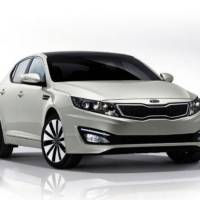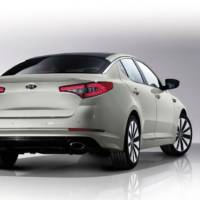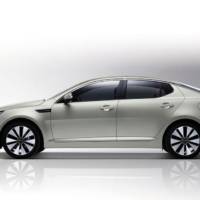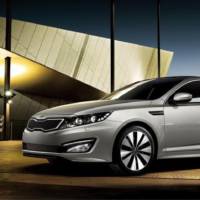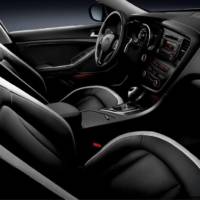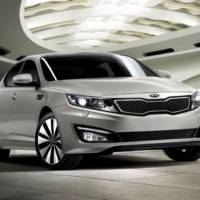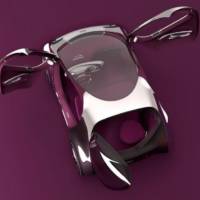Besides presenting the Kia POP concept, the Korean manufacturer has also brought the 2011 Kia Optima for its first European appearance.
Expected to go on sale in Europe on mid-to-late 2011, the 2011 Kia Optima is expected to enhance Kia’s presence in the D-segment.
The 2011 Kia Optima European spec version will be available with two engine choices. The first is a 1.7-litre 4-cylinder VGT diesel producing 136 PS and 330 Nm of torque thanks to which CO2 emissions are expected to be 113 g/km when fitted with Kia’s ISG Start/Stop system.
The second engine option for the 2011 Kia Optima European spec is a 2.0-litre CVVL (continuously variable valve lift) gasoline engine developing 170 PS at 6,200 rpm and 196 Nm of torque at 4,300 rpm.
The 2011 Kia Optima European spec also comes with fully independent front and rear suspension, hydraulic power steering, and a luggage space capacity of 505-litres.
On the Standard features list the 2011 Kia Optima will include manual air-conditioning, electric windows front and rear, CD/Stereo
with 6 speakers, keyless-entry with alarm system, mirror LED
turn signals, windshield de-icer and folding rear
centre armrest with twin cup-holders.
Pricing for the 2011 Kia Optima European spec version was not announced.
Kia press release :
* All-new vehicle expected to significantly grow Kia’s presence in the D-segment
* Stunning looks build upon Kia’s recent design-led product offensive
* CO2 emission levels as low as 113g/km from an efficient engine line-up
* High-tech premium options such as automatic parking to be available
The striking new Kia Optima is making its European debut at the 2010 Paris Motor Show.
The bold and dynamically-styled D-segment saloon made its world premiere at the New York International Auto Show in April this year.
When Kia Optima goes on sale in Europe in mid-to-late-2011 it is expected to significantly grow the company’s market share in the D-segment – inspiring and challenging consumers to consider a Kia.
Kia Optima is an all-new car from the ground up. Longer, lower, wider and with a longer wheelbase than any previous D-segment offering from Kia, it embodies what Kia’s Chief Design Officer Peter Schreyer calls “a bold, athletic and visual sporting energy”.
The product concept behind the creation of the newcomer focused on four key areas. Stand-out Styling – a unique exterior with a driver-oriented interior, Class-leading Performance – down-sized but more efficient engines with six-speed transmissions, Superior Packaging – new, longer wheelbase platform and Advanced Features – high-tech premium options.
The car which resulted from this product concept has already had a rapturous reception. Launched in the Korean market earlier this year, the car was an instant hit, with monthly sales exceeding 10,000 units in June and July to claim the ‘best seller’ position for Kia for the very first time.
The Kia Optima’s specification will be tailored to European tastes, with buyers offered a choice of either petrol or diesel engines – both with performance and economy figures among the very best in class.
The engine line-up will comprise either a new highly-efficient ‘U2’ 1.7-litre VGT diesel engine which produces 136 ps and promises best-in-class emissions (113 g/km when fitted with Kia’s fuel-stretching ISG Start/Stop system) or an all-new technically-advanced ‘Nu’ 2.0-litre CVVL (continuously variable valve lift) gasoline engine producing 170 ps.
The new model will also offer a dynamic and responsive driving experience, combined with a high standard specification and a range of optional high-tech features usually associated with premium brand vehicles.
“With the new Kia Optima, our global design team has penned a vehicle with distinctive dimensions and proportions that stands apart from everything else in its segment. Using an all-new mid-size platform and an all-new bodyshell, it moves our saloon product up to the next level of our design revolution,” commented Benny Oeyen, Vice President Marketing, Kia Motors Europe.
“In spite of the ongoing global economic uncertainties, Kia’s market research indicates that demand for D-segment saloons in many countries will grow steadily over the next three years. We anticipate segment sales rising by 23% from 4.3 million last year to 5.3 million in 2013. While we expect the segment to shrink in Western Europe, Kia wants to gain a bigger share of this sector.
“Customer clinics with the new car have generated strongly positive responses and we are confident that the all-new Kia Optima will greatly boost our presence in the segment around the world,” concludes Oeyen.
As with all Kia models sold in Europe, the newcomer will be offered to consumers with the manufacturer’s unique 7-Year / 100,000 mile warranty, which is fully transferable to subsequent owners.
Styling – ‘a bold declaration of intent’
Designed under Schreyer’s guidance by Kia design teams in Frankfurt, Germany and Irvine, California, the new model inspires and challenges European D-segment consumers to consider a Kia.
“With our new sedan, we have created a product that people previously would not have expected from Kia and that’s exactly what we set out to achieve!“ asserts Kia’s Chief Design Officer Peter Schreyer.
“Kia Optima is more than one step ahead of the car it replaces – it’s a clean sheet design that owes nothing to its predecessor. In every detail you will recognize our bold declaration of intent to grow Kia’s market share in this segment. Through the balance of its muscular proportions and the elegant simplicity of its raked roofline, our design results in a car that radiates self-assurance and confidence from every angle.
“It marks a new strand in Kia’s evolving design DNA with a blend of simple and fluid lines and elegant but uncomplicated shapes drawing the attention of the eye in much the same fashion as a perfectly-tailored fine Italian suit,” adds Schreyer.
The high, pronounced shoulder line, sculpted flanks and boldly flared wheel arches create a saloon with a graceful, muscular stance. Kia Optima’s coupe-like profile enhances the feeling of dynamism whilst also delivering improvements in aerodynamic efficiency. With a coefficient of drag figure of 0.29 – down from 0.32 for the previous generation model – refinement, performance and fuel economy are all enhanced.
A special ‘Sport Package’ including a unique front mesh grille, new front and rear bumpers, sculpted side sills, rear ‘lip type’ spoiler, LED daytime running lights, LED rear combination lamps, aero-blade windscreen wipers, plus high performance dampers, larger disc brakes with black callipers and machine-finished 18-inch, 10-spoke, flush-faced, alloy wheels will be available.
Engines – offering best-in-class performance and low emissions
The new model will be available to European consumers from launch with a choice of two engines – a 2.0-litre 170 ps petrol engine and a 1.7-litre 136 ps diesel, which is expected to account for the majority of sales in Europe. Also offered at a later date will be a higher output (160 ps) version of the 1.7-litre diesel.
Reacting to market demands for smaller, more fuel-efficient engines, the diesel powerplant offered is a new 1.7-litre version of Kia’s popular ‘U2’ engine. Fitted with a Variable Geometry Turbocharger (VGT) the new engine produces 136 ps and 330 Nm of torque for excellent driveability, and delivers best-in-class performance for an engine of its displacement (83 ps per litre).
A number of measures designed to enhance engine efficiency, including fitting an overrunning alternator decoupler and an innovative battery management system, also mean that Kia Optima will have the best emissions figures in class – producing just 122 g/km CO2.
Drivers keen to reduce the environmental impact of their car even further can select Kia’s optional ISG Start/Stop system, which automatically switches off and restarts the engine in heavy traffic conditions. Fitted with ISG, Kia Optima is able to deliver a remarkable CO2 output of just 113 g/km, placing it among the lowest vehicle tax bands in most European countries.
The 2.0-litre petrol engine is an all-new powerplant. Code-named, appropriately, ‘Nu’ the new lightweight engine offers best-in-class performance (85 ps per litre), and competitive fuel economy. Continuously Variable Valve Lift (CVVL) boosts performance and economy (5.5 per cent improvement, compared to non-CVVL engine of the same displacement).
In the interests of increasing fuel efficiency, Kia’s engineers employed various technologies in developing the Nu powerplant, including a two-stage variable induction system, an electronic throttle body and an off-set crank.
In all markets, the all-new Kia Optima will be offered with either a six-speed manual or six-speed automatic transmission.
Enhanced standard and optional premium features
True to the company’s philosophy of producing cars that present excellent value for money, Kia Optima will be fitted with generous levels of specification as standard, and buyers will also be offered a number of optional high-tech features typically found on vehicles from premium brands.
Fitted as standard for all trim levels is a powered lumbar support for drivers seat, and although the final standard specification may vary country-by-country, a typical lower trim vehicle will feature bright chrome A- to C-pillar trim moulding, manual air-conditioning, electric windows front and rear, CD/Stereo with 6 speakers, keyless-entry with alarm system, outside mirror LED turn signals, aero blade wipers, windshield de-icer and folding rear centre armrest with twin cup-holders.
Available as standard on higher trim levels or as options are features such as automatic folding mirrors and Smart Parking Assist (SPA) – a feature which automatically parks the vehicle.
Buyers will also be presented with a range of state-of-the-art active and passive safety systems and equipment as standard – or as options, depending on model and market.
Technical specifications:
2.0-litre petrol
Type: ‘Nu’, 1999cc four-cylinder with CVVT and DOHC
Power / Torque: 170 ps @ 6200 rpm / 196 Nm @ 4300 rpm
Emissions: TBC
1.7-litre diesel
Type: ‘U2’, 1685cc four-cylinder with VGT and DOHC
Power / Torque: 136 ps @ 6300 rpm / 330 Nm @ TBC
CO2 Emissions: 122 g/km (113 g/km when fitted with ISG Start/Stop system)
Suspension & Damping
Front: Fully independent. MacPherson struts, with coil springs and twin-tube gas-filled shock absorbers. Anti-roll stabiliser bar.
Rear: Fully independent multi-link. Coil prings and twin-tube gas-filled shock absorbers. Anti-roll stabiliser bar.
Steering
Type: Hydraulic power-assisted rack and pinion
Gearing: 2.94 turns lock-to-lock
Turning circle: 10.9 metres
Brakes
Front: 300 x 28 mm ventilated discs (320 x 28 mm for 18-inch wheels)
Rear: 284 x 10 mm solid discs
Wheels & Tyres
Standard/base spec: Steel 16 x 6.5J with 205/65R16 tyres
Optional/higher spec: Alloy 16, 17 or 18-inch, with 205/65R16, 215/55R17 or 225/45R18
Dimensions
Overall length 4845 mm
Overall width 1830 mm (excluding door mirrors)
Overall height 1455 mm
Wheelbase 2795 mm
Front overhang 965 mm
Rear overhang 1085 mm
Front track 1601 mm
Rear track 1601 mm
Capacities
Fuel tank: 70-litres
Luggage (VDA): 505-litres
Performance
Top speed (km/h) TBC
0-100km/h (sec) TBC
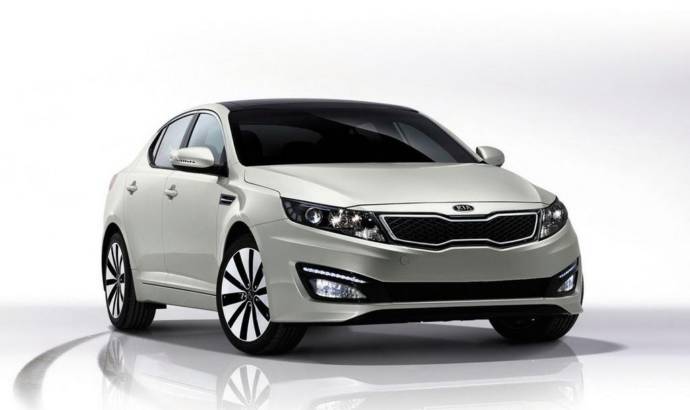
30 Sep 2010
0

